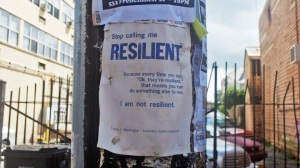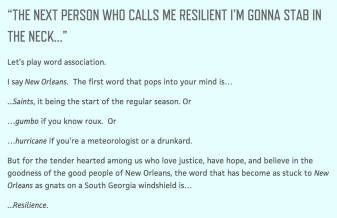Resilience, n., “Elasticity; the power of resuming an original shape or position after compression, bending, etc.”
“The quality or fact of being able to recover quickly or easily from, or resist being affected by, a misfortune, shock, illness, etc.; robustness; adaptability.”
“Resilience” is everywhere, its popularity rising proportionally with the dangers, or perceptions of dangers, facing the planet: climate change, food shortages, financial crisis, or for the Wall Street journal crowd, strikes (also fire and hurricanes). The definitions of the currently voguish term differ, but most trace its origin to C.S. Holling, an environmental scientist who defined it as “a measure of the persistence of systems and of their ability to absorb change and disturbance and still maintain the same relationships between populations.” The field Holling pioneered, “ecological economics,” applied this concept to the management of natural resources, especially in the third world, which has made “resilience” part of the rhetorical arsenal of “sustainable development.”
It is also common in the language of humanitarian relief, where a people’s “resilience to crisis” is thought to be proactive preparation for disaster, rather than a reactive response to it. Note the grammatical strangeness of this neological construction, as if “resilience to” is literally replacing “resistance to.” While there may indeed be practical benefits to planning in this way, the problem, as Julian Reid and Brad Evans write in their excellent new book Resilient Life: The Art of Living Dangerously, is that we apply the word “resilient” to a population “insofar as it adapts to rather than resists the conditions of its suffering in the world.”
“Resilience” is a mainstay of pseudo-scientific self-help literature that drives the “wellness” and “mindfulness” industry, in which one’s physical and spiritual health is defined in terms of one’s ability to “bounce back” from hardship. This assumes three things: as we saw with “wellness,” health becomes the individual’s personal responsibility, and poor health his own failure; it is a receding horizon, since one can always be more well or more resilient; thirdly, it presumes catastrophe and crisis to be baseline conditions of everyday existence without questioning why this is, or whether it should be.
Finally, “resilience” has been taken up enthusiastically by the purveyors of click-baity executive pablum in places like Fast Company and Harvard Business Review, which produce endless lists of the 5, 10, or 7 habits of “resilient” executives, employees, or companies. “Why do some people and some companies buckle under pressure?” asks HBR in one such article. “And what makes others bend and ultimately bounce back?” The unstated implication is that some entrepreneurs, we won’t say who, just wet the bed under pressure. Don’t be one of those.

In humanitarian and development discourse, resilience talk often reads as a form of sympathizing with a local, usually impoverished population and praising their strength in the face of hardship. Such professions of sympathy, however sincere or well intentioned, can quickly become powerfully cynical if they do not consider history, power, and the distance between the “resilient” subject and the person or institution calling them such. This is the point of a much-circulated poster in post-Katrina New Orleans, which bore a quotation attributed to a local lawyer, Tracie Washington: “Every time you say, ‘Oh, they’re so resilient,’ that means you can do something else to me.”

“Resilience” becomes a way of assessing the post-disaster situation sociologically without treating it politically. Haitians have also endured much of this faint praise. The USAID called Haitians “the most resilient people on earth” after the 2010 earthquake, which seems like a vague allusion not just to the disaster response but to the country’s longer history of oppression and resistance that we vaguely know but which cannot be named. Swap “resilient” for “oppressed” or “revolutionary,” though, and you would have quite a different USAID press release.
The heroic narrative of Black sufferers that endure cruelty and misfortune with stoic resolve has, of course, a long history. In “Many Thousands Gone,” James Baldwin referred to Aunt Jemima and Uncle Tom, those depthless objects of white affection, as “prodigies of resilience,” preternaturally gifted with the power to endure pain. Despite its scientific origins, many common uses of resilience are quite sentimental, partly because they seem to tell us more about the speaker of the praise, rather than its object. This praise is also empty, coming as it does without distinction–we are hard-pressed to name the country that responded to a devastating hurricane or earthquake unresiliently.
Given its slippery usage, it is perhaps appropriate that the word’s Latin root is resilientia, or “fact of avoiding.” Its earliest meaning comes from engineering, where it refers to the flexibility or elasticity of an object. Only later was it applied figuratively by Holling to an ecosystems’ capacity to absorb change: the currently voguish appropriations of “resilience” are therefore metaphors for a metaphor: “resilient” people borrow the capacities of ecosystems to recover from crisis, and this ecological meaning was in turn borrowed from an object’s ability to bend. What is often lost along the way is Holling’s rather limited application: a “resilient” biological system does not “adapt” (he gave this term a different meaning, even though the OED uses it as a synonym), nor does it “bounce back,” as a ball springing off a “resilient” object would,or recover its original state, as a “resilient” piece of putty might: it simply persists in an altered but basically intact state. It doesn’t break, but this doesn’t mean it is not damaged.
The bestselling book Resilience: Why Things Bounce Back, which received the imprimatur of the New York Times op-ed page, shows how elastic the term can be. Although their subtitle defines resilience as “bouncing back,” authors Andrew Zolli and Ann Marie Healy define the term more narrowly as “the capacity of a system, enterprise, or a person to maintain its core purpose and integrity in the face of dramatically changed circumstances,” which also confuses three categories–complex “systems” (whether economic or political), private businesses, and individuals–often better thought of as antagonists.
Their opening anecdote, the Mexico City tortilla riots of 2007, is telling as an example of the present sense of crisis that motivates “resilience” talk, and of its acquiescence to that crisis. As Zolli and Healy write, theMexico City demonstrations erupted after world corn prices skyrocketed, drastically increasing the local price of tortillas. Although they recognize the role of U.S. corn subsidies and ethanol production in inflating corn prices, the authors attribute the riots to Hurricane Katrina–a “natural” disaster–which damaged oil refineries and encouraged the planting of more ethanol corn. Zolli and Healey also acknowledge how NAFTA has allowed U.S. corn to dump their product on Mexico, but oddly, these causes are treated not as political circumstances but as metaphorical hurricanes: since “we cannot control the volatile tides of change,” they write, “we can learn to build bigger boats.”
Okay, so the word “resilience” takes its urgency from global destitution, hunger, and a forthcoming environmental cataclysm, but damn it, what’s the good news? “The good news,” an enthusiastic Forbes contributor writes, “is that everyone can learn the habits of mind that can better prepare themselves and their institutions for unanticipated change and become more prosperous, safe, and happy in the process.”
The Mexico City example reminds me of something George W. Bush’s Ambassador to Ecuador told a group of Fulbright fellows I was a part of sometime in 2006. Those of us on fellowships in the Andean countries were in Quito for a conference, which featured a Q & A with the Ambassador. That week, the Bush administration was negotiating a free-trade agreement that would require the Ecuadorean government to cut subsidies on its domestic corn, naturally without requiring Washington to do the same. (Large-scale protests planned for the coming days would eventually scuttle the deal.) One of our group–as I recall, an agronomist working with campesinos in rural Ecuador–asked the Ambassador what she should tell the farmers in the district where she was living, where people had been harvesting corn for generations, probably since pre-Columbian times. The Ambassador’s response, whose arrogance actually shocked me at the time: “I would tell them to grow broccoli.”
She was imploring these farmers to become more “flexible,” in other words, lest they be driven off their land into the overcrowded slum cities–where they would then be required to get “resilient,” and in a hurry. The resilience metaphor borrows from the engineering the concept of elasticity or flexibility–the ability to respond “nimbly” to external shocks. As Alan Greenspan said in a 2004 speech, “the increased flexibility of our labor market is now judged [by whom?] an important contributor to economic resilience,” and the IMF agrees that the most “resilient” economies have the most “flexible” labor and commodity markets.
These example are of course part of a long tradition of naturalizing our contemporary political and economic order, treating food shortages and layoffs as if they are acts of nature. We can see endless examples of this in entrepreneurial discourse: see the talk about “innovation ecosystems” and “innovation energy,” in which innovation pseudo-science verges on New Age nature-worship (“You can just feel the innovation energy at this Chinese-government funded Microsoft technology campus, man.”) But as Evans and Reid write in their book, it also a measure of the absorption of sustainable development’s original ecological critique of capitalism: innovation “ecosystems” now help to provide the “balance” that environmental restrictions were supposed to ensure.
Resilience began to be conceived not simply as an inherent property of the biosphere, in need of protection from the economic development of humanity, but a property within human populations that now needed promoting to the increase of their ‘economic options.’ Remarkably, then, the biosphere itself began to be conceived not as an external economic domain…but an economy of ‘services’ which humanity receives.
Resilience, once a property of the environment, becomes a property of people; at the same time, wealth is a property of the environment, while its costs are borne by the people who work it. Those most vulnerable to the environmental shocks associated with modern capitalism are also the ones charged with becoming more “resilient” against them. As a New Orleans blog, Catfish for Lunch, puts it more bluntly: “When we celebrate resilience, we focus the spotlight on the people who got screwed over. The institutions that did the screwing over take the opportunity to slink off into the shadows.”


Reblogged this on the anthropo.scene.
LikeLiked by 1 person
[…] * Keywords for the Age of Austerity 19: Resilience. […]
LikeLike
This whole blog is brilliant.
LikeLike
[…] User Team Synergy Sustainability Stakeholder Self-Starter Resilience Pivot Peaceful Protest Nimble Learning Outcomes Leadership Innovation Flexibility Failure Errors in […]
LikeLike
[…] note at the same that our present age of austerity requires of us resilience as a psychological characteristic. University counseling centers now have resilience training, and […]
LikeLike
Reading this, in addition to reading your post on ‘Pivot’, leads me to think that these terms are being used in a pattern that brings to mind another term ‘Evasion’.
I can almost hear it now. “Let’s pivot our global perspectives in such a way that places emphasis on resilience”
Because in no way is anyone in such a speaking capacity willing to suggest that maybe there’s some part of our global system that we need to change.
LikeLike